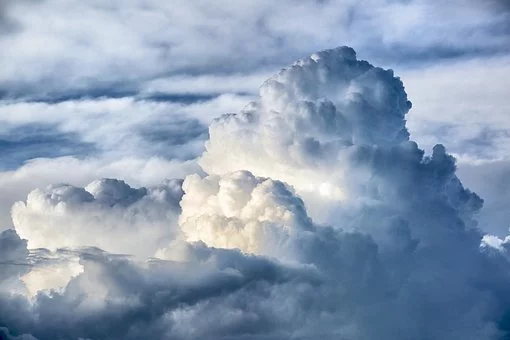Clouds!
Clouds are an important part of the water cycle. The
water cycle is the movement of water from the Earth into the
sky and then back down to the Earth again. Over 70% of the Earth is covered in water! Water on the Earth is
in the form of salt
water (97%), which is water that is found in the oceans and saltwater lakes, and fresh
water (3%), which is water that is found in rivers, ponds, lakes, streams, and
underground.
The sun heats water on the surface of the Earth, and causes it to
evaporate. Evaporation is the process when water moves from being a
liquid to
being vapor. Water vapor is made up of tiny water droplets in the air. Water can
also move into the air through transpiration. Transpiration is the
movement of
water out of plants. During photosynthesis, plants make oxygen and water. Water
then moves out of tiny holes on the leaves and into the air. The water vapor rises
up into the atmosphere, and as it cools, it condenses. When the water vapor
condenses it forms clouds. Precipitation occurs when so much water
vapor
condenses that the air cannot hold it anymore. The clouds get so heavy that
some of the water must fall back down to Earth as rain, snow, sleet, or hail.
There are many different types of clouds. The type of cloud depends on
how high up in the atmosphere the water condenses. Read about different types of clouds below! Click on each
button for more info.
The three types of cloud above are the main types; but there are also combination clouds. Click each one
below to read more!
Take the short quiz below to test your knowledge! Try your best to answer without looking above.
Photo Credits: Stratocumulus: By Nicholas A. Tonelli from Pennsylvania, USA - Drive-Through, CC BY 2.0,
https://commons.wikimedia.org/w/index.php?curid=21218979;
Nimbostratus: CC BY-SA 3.0,
https://commons.wikimedia.org/w/index.php?curid=74402;
Altostratus:
By The Great Cloudwatcher - Own work, CC BY-SA 3.0, https://commons.wikimedia.org/w/index.php?curid=17465322;
Altocumulus:
By Bidgee - Own work, CC BY-SA 3.0, https://commons.wikimedia.org/w/index.php?curid=6204153;
Cirrostratus: CC BY-SA 3.0, https://commons.wikimedia.org/w/index.php?curid=246913;
Cirrocumulus: By King of Hearts - Own work, CC BY-SA 3.0,
https://commons.wikimedia.org/w/index.php?curid=10903373;
Cumulonimbus: By Pitero 86 - Own work, CC BY-SA 4.0, https://commons.wikimedia.org/w/index.php?curid=36192329;


